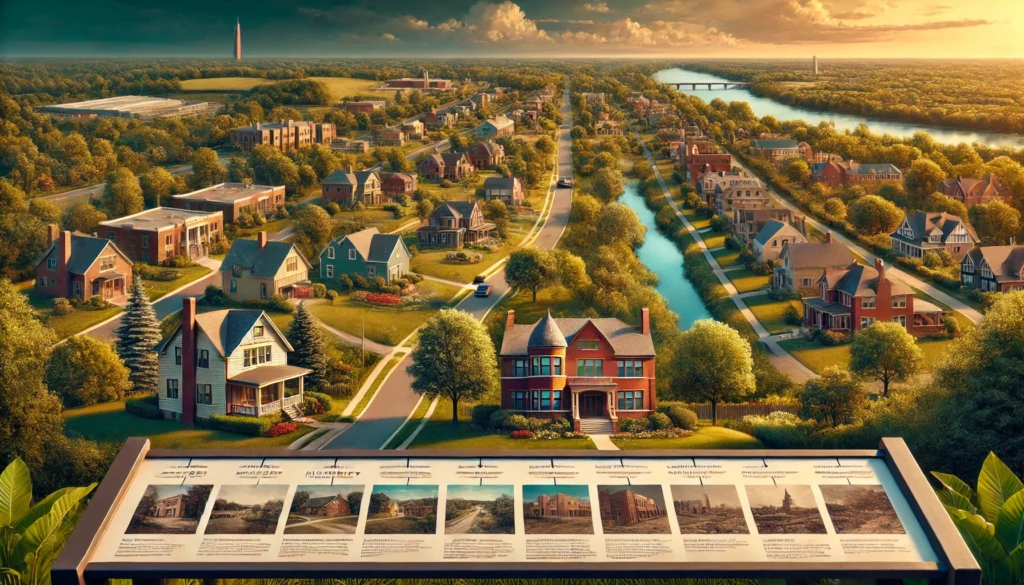Lincolnshire, Illinois, may have a more recent history compared to other towns in the region, but its story is one of thoughtful development, community spirit, and strategic planning. While its history might not span centuries, the village has made significant strides since its incorporation in 1957. So, what is it about Lincolnshire’s history that sets it apart from other suburbs? Let’s explore its journey from early settlement to a thriving, modern community.

Early Settlement: From Native American Lands to Farmlands
Before European settlers arrived, the area that is now known as Lincolnshire was home to Native American tribes, particularly the Potawatomi. The land was rich with natural beauty, providing a sustainable environment for these indigenous peoples. As European settlers began arriving in the mid-19th century, the region transitioned into a farming community, with agriculture playing a crucial role in its early development.
During this period, much of the land was used for farming, and it remained largely rural until the mid-20th century. The area’s fertile soil and proximity to Chicago made it an ideal place for settlers to cultivate crops, but major changes were on the horizon.
Incorporation and Naming: Honoring Abraham Lincoln’s Legacy
It wasn’t until 1957 that Lincolnshire was officially incorporated as a village. The decision to name the village “Lincolnshire” was a nod to the area’s patriotic roots, with the name chosen in honor of President Abraham Lincoln. This choice of name reflects the village’s deep respect for American heritage and the ideals of democracy and freedom that Lincoln himself championed.
The incorporation marked a turning point for the area as it transitioned from farmland to an organized, planned suburban community. Developers saw an opportunity to create something special in the region, and they seized it.
Planned Development: A Vision for Upscale Living
In the 1950s, developers Ira Younge and Ralph Hughes purchased a significant portion of land in what would become Lincolnshire. Their goal was to create an upscale suburban retreat, a vision that would combine high-quality living with ample green spaces and recreational amenities. This forward-thinking development plan was centered on preserving the area’s natural beauty while also providing modern conveniences for residents.
The village was carefully planned with attention to detail, ensuring that green spaces and parks were integrated into the layout. Recreational facilities were developed, and the natural beauty of the area was preserved as much as possible. This planning made Lincolnshire an attractive destination for families and individuals seeking a peaceful suburban lifestyle.
Growth and Expansion: From Residential to Corporate Hub
As the 20th century progressed, Lincolnshire experienced steady growth. Residential neighborhoods flourished, and the village expanded to include commercial areas and office spaces. What was once farmland transformed into a balanced mix of residential, business, and recreational spaces.
One of the key aspects of Lincolnshire’s growth has been its attractiveness to businesses. Over the years, several corporate headquarters have chosen to make Lincolnshire their home, contributing to the village’s economic prosperity. This combination of residential and commercial growth helped solidify Lincolnshire’s reputation as both a desirable place to live and work.
Cultural and Recreational Offerings: The Heart of Lincolnshire
While Lincolnshire may be known for its well-planned neighborhoods and corporate presence, its cultural and recreational offerings are equally impressive. One standout feature is the Marriott Theatre, established in 1975, which has become a renowned regional theater. Hosting a variety of productions throughout the year, the theater attracts both locals and visitors, adding a rich cultural dimension to the village.
In addition to its cultural attractions, Lincolnshire boasts a strong commitment to recreational spaces. Parks, trails, and facilities have been established to encourage outdoor activities and foster a sense of community. The village’s focus on recreational offerings ensures that residents have access to nature and opportunities for healthy living.
Community Spirit: A Village Built on Strong Values
Lincolnshire is not just about beautiful homes and cultural venues; it’s also a village that values community engagement. The Lincolnshire-Riverwoods Fire Protection District plays an essential role in ensuring the safety of residents, providing fire and emergency services that enhance the village’s quality of life.
Education is another key pillar of the Lincolnshire community. With several highly-rated schools serving the area, the village has invested in ensuring that families have access to top-tier educational opportunities. This focus on education reflects Lincolnshire’s long-term commitment to building a prosperous and well-rounded community.
Today’s Lincolnshire: A Blend of Prosperity and Community Spirit
Today, Lincolnshire stands as a thriving, well-planned suburb located in Lake County, Illinois. Its blend of upscale residential areas, thriving commercial centers, cultural attractions, and community spirit makes it a standout destination for anyone looking for a high quality of life.
The village’s historical journey may be relatively short, but its emphasis on thoughtful development, respect for nature, and community engagement has left a lasting mark. Lincolnshire’s commitment to preserving its heritage while looking toward the future has made it a unique and desirable place to call home.
Conclusion
The history of Lincolnshire, Illinois, reveals a village that was built on careful planning, respect for natural beauty, and a commitment to community. From its early days as farmland to its development into a prosperous and culturally rich suburb, Lincolnshire’s history speaks to its dedication to quality of life. As the village continues to grow, it will undoubtedly maintain the values and spirit that have shaped it over the decades.
For those interested in learning more or becoming part of this vibrant community, Lincolnshire’s blend of history, culture, and modern living offers something truly special.
